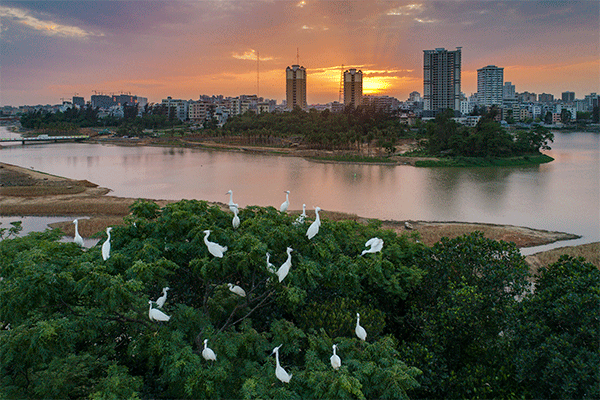As the early morning sun sits low on the horizon above the azure waters of the South China Sea, Liang Feng busies himself on the shores of Zhaoshu Island before the heat of the day sets in.
The former fisherman from Qionghai is one of many chiefs that safeguard the ecological environment on the islands of China's southernmost province, Hainan, the largest with 2.2 million square kilometers of sea territorial waters under its jurisdiction.
Zhaoshu Island is tiny at only 0.29 square kilometers, but Liang diligently patrols its shores twice a day, picking up plastic bottles and rubbish, as well as keeping an eye on boats in the area and reporting any illegal activities.
This island chief system was established in Sansha, the southernmost city of Hainan, in 2017 as a measure to safeguard the province's many ecological treasures.
The system forms part of a greater blueprint to make tropical Hainan a pleasant home for its residents, as well as an ideal destination for domestic and overseas tourism. Safeguarding its fertile, green mountains, clear waters and blue sky is key to making sure the blueprint becomes a reality.
Liang Feng is one of the people who are closely involved in making sure local development stays within the boundaries.
Liu Cigui, Party chief of Hainan, said the island's ecological resources are its best capital and biggest advantage to help it become an international tourism destination and attain sustainable development.
A chief system is being implemented around Hainan to ensure good care of its rivers, bays and mountains, as well as its 1,823 kilometers of coastline, to better tackle environmental pollution problems.
The system requires officials at every level of the government to take full responsibility for the protection of rivers and lakes in regions under their jurisdiction, according to the provincial government.
So far, Hainan's 197 rivers and lakes have gotten their own chiefs under the mechanism, water quality of 64 rivers and lakes has been remarkably improved, including Meishe River in Haikou capital city of Hainan.
Following a strict campaign to protect Meishe river, fish have returned in abundance, joined by mangroves, dubbed guards of the seashores, planted along the river bank. The once mistreated river is now a welcome spot for public activities and tourists.
Starting from this year, Hainan will cancel the traditional way of GDP growth evaluation for its local leaders in 12 cities and counties, including Baoting, Baisha, Changjiang, Wuzhishan, Lingao, Shen Xiaoming, governor of Hainan said.
The reason is that these are core ecological resources areas where commercial real estate projects will be forbidden to make way for a greener approach to protect the tropical island's unique ecology.
Traditional key factors, such as GDP growth, industrial production and fixed-asset investment, will no longer be decisive elements for local leaders. Instead, they will be evaluated on their achievements in environmental protection.
And on that front, more than 133,300 hectares of trees have been planted in the past five years, lifting forest coverage to 62.1 percent, ranking it among the country's top three, according to official data.
The air quality in Hainan has remained among the nation's best for years. Data released by the Ministry of Environmental protection said Haikou continued to have the cleanest air out of China's 74 major cities last year, followed by Lhasa in Tibet autonomous region and Zhoushan in Zhejiang province.

Egrets make their nests at Meishe River Wetland Park in Haikou after a recovery of the ecosystem in the city. [Long Quan/For China Daily]